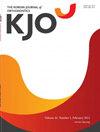Longitudinal management of recurrent temporomandibular joint ankylosis from infancy to adulthood in perspective of surgical and orthodontic treatment
IF 1.9
3区 医学
Q1 Dentistry
引用次数: 3
Abstract
This study was performed to describe the longitudinal management of recurrent temporomandibular joint (TMJ) ankylosis from infancy to adulthood in perspective of surgical and orthodontic treatment. A 2-year-old girl was referred with chief complaints of restricted mouth opening and micrognathia due to bilateral TMJ ankylosis. For stage I treatment during early childhood (6 years old), high condylectomy and interpositional arthroplasty were performed. However, TMJ ankylosis recurred and symptoms of obstructive sleep apnea (OSA) developed. For stage II treatment during early adolescence (12 years old), gap arthroplasty, coronoidectomy, bilateral mandibular distraction osteogenesis, and orthodontic treatment with extraction of the four first premolars were performed. However, TMJ ankylosis recurred. Because the OSA symptoms reappeared, she began to use a continuous positive airway pressure device. For stage III treatment after completion of growth (20 years old), low condylectomy, coronoidectomy, reconstruction of the bilateral TMJs with artificial prostheses along with counterclockwise rotational advancement of the mandible, genioglossus advancement, and orthodontic treatment were performed. After stage III treatment, the amount of mouth opening exhibited a significant increase. Mandibular advancement and ramus lengthening resulted in significant improvement in the facial profile, Class I relationships, and normal overbite/overjet. The OSA symptoms were also relieved. These outcomes were stable at the one-year follow-up visit. Since the treatment modalities for TMJ ankylosis differ according to the duration of ankylosis, patient age, and degree of deformity, the treatment flowchart suggested in this report could be used as an effective guideline for determining the appropriate timing and methods for the treatment of TMJ ankylosis.从婴儿期到成年期复发性颞下颌关节强直的外科和正畸治疗的纵向管理
本研究旨在从手术和正畸治疗的角度描述从婴儿期到成年期复发性颞下颌关节(TMJ)强直的纵向管理。一名2岁女童因双侧颞下颌关节强直导致开口受限和小颌畸形。对于儿童早期(6岁)的I期治疗,进行高位髁突切除术和关节置换术。然而,颞下颌关节强直复发并出现阻塞性睡眠呼吸暂停(OSA)症状。对于青春期早期(12岁)的II期治疗,进行间隙关节置换术,冠状切除术,双侧下颌牵张成骨以及拔除四颗第一前磨牙的正畸治疗。然而,颞下颌关节强直复发。由于呼吸暂停症状再次出现,她开始使用持续气道正压通气设备。生长完成后(20岁)的III期治疗,行下髁突切除术、冠状切除术、双侧颞下颌关节人工假体重建及下颌逆时针旋转前移、颏舌肌前移和正畸治疗。经III期治疗后,口腔张开量明显增加。下颌前移和支延长显著改善了面部轮廓、I类关系和正常的复咬合/复咬合。呼吸暂停症状也得到缓解。在一年的随访中,这些结果是稳定的。由于TMJ强直的治疗方式根据强直的持续时间、患者的年龄和畸形程度而有所不同,本报告提出的治疗流程图可作为确定TMJ强直治疗的合适时机和方法的有效指南。
本文章由计算机程序翻译,如有差异,请以英文原文为准。
求助全文
约1分钟内获得全文
求助全文
来源期刊

Korean Journal of Orthodontics
Dentistry-Orthodontics
CiteScore
2.60
自引率
10.50%
发文量
48
审稿时长
3 months
期刊介绍:
The Korean Journal of Orthodontics (KJO) is an international, open access, peer reviewed journal published in January, March, May, July, September, and November each year. It was first launched in 1970 and, as the official scientific publication of Korean Association of Orthodontists, KJO aims to publish high quality clinical and scientific original research papers in all areas related to orthodontics and dentofacial orthopedics. Specifically, its interest focuses on evidence-based investigations of contemporary diagnostic procedures and treatment techniques, expanding to significant clinical reports of diverse treatment approaches.
The scope of KJO covers all areas of orthodontics and dentofacial orthopedics including successful diagnostic procedures and treatment planning, growth and development of the face and its clinical implications, appliance designs, biomechanics, TMJ disorders and adult treatment. Specifically, its latest interest focuses on skeletal anchorage devices, orthodontic appliance and biomaterials, 3 dimensional imaging techniques utilized for dentofacial diagnosis and treatment planning, and orthognathic surgery to correct skeletal disharmony in association of orthodontic treatment.
 求助内容:
求助内容: 应助结果提醒方式:
应助结果提醒方式:


